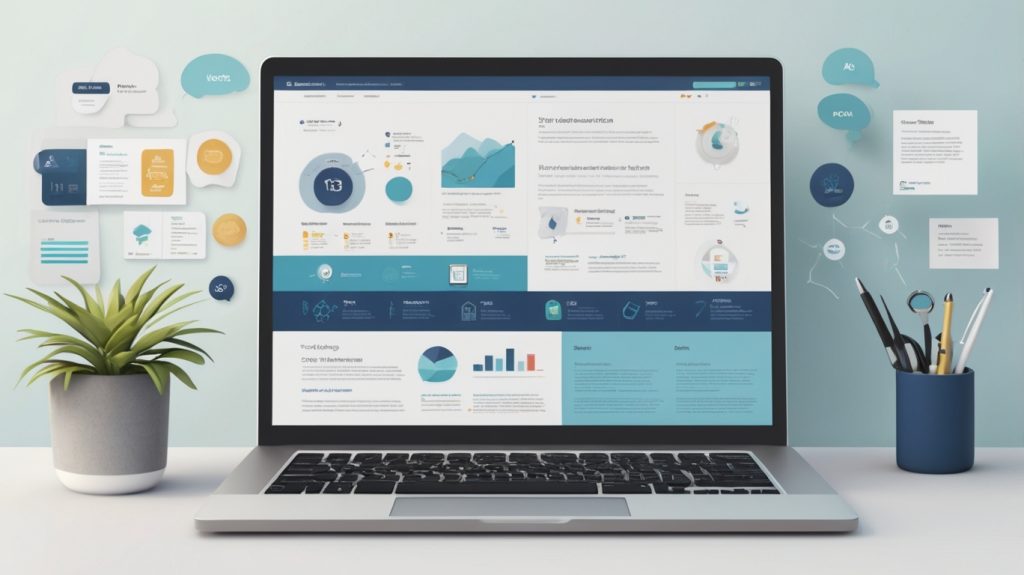
Table of Contents
ToggleA beginner’s guide to building a simple, effective site structure
This is the first post in a series for beginners learning to make their first website, and one of the first questions you may ask is, What pages do I need on my website? You might have seen large sites with endless menus, pop-ups, blogs, testimonials, and all sorts of bells and whistles. But if you’re just starting out, you don’t need all of that. In fact, trying to include everything from day one can actually hurt your website — making it harder to navigate, slower to load, and more difficult for visitors to understand.
Why Website Structure Matters
A clear website structure helps visitors understand your content quickly and navigate your site with ease. When your pages are organised in a logical way, it becomes easier for people to find what they’re looking for, take action, and return again in the future.
From a search engine point of view, structure also plays a key role. Search engines use headings, internal links, and page layout to determine what your website is about and how different pages relate to each other. A well-structured website can improve your visibility in search results and help more people discover your business online.
Good structure also supports accessibility, making sure that assistive technologies can interpret and present your content correctly to users with visual or cognitive impairments.
In short, clear and consistent structure supports better results across user experience, search performance, and accessibility.
The 4 Essential Website Pages
1. Home Page
This is the front door of your website — your digital welcome mat. It should tell people three things quickly:
Who you are
What you do
What you want them to do next
Include:
A clear, simple introduction
An overview of your services or offerings
A call-to-action (like ‘Get in touch’, ‘Book a free call’ or ‘Shop now’)
Quick links to other important pages
Your homepage doesn’t need to say everything — just enough to make people want to click further.
2. About Page
This is your chance to build trust and connection. People like knowing who they’re buying from or working with.
Include:
A brief story about your business or journey
Your values or approach
A photo of you (if you’re comfortable)
Testimonials or credentials (if you have them)
Keep it friendly and human no need to write it like a CV!
3. Services or Products Page
This is where you go into more detail about what you offer.
If you’re a service-based business:
Outline each service clearly
Include pricing if possible
Add a short description and who it’s for
If you’re selling products:
Make sure each product has its own page or listing
Use good quality photos and clear descriptions
Consider grouping services or products into categories to keep things easy to browse.
4. Contact Page
You don’t need a dozen ways to be contacted — just make it easy for someone to reach you.
Include:
An email address or contact form
Social media links (if you use them for business)
Business hours (if relevant)
Location or service area
Make sure your contact page is always easy to find in your navigation.
Helpful Optional Pages
Once your core pages are live, you can add extra pages to support your business goals:
Blog or News
Useful for sharing helpful content, updates, or showing your expertise. Great for SEO too.
Testimonials / Reviews
Build trust with real feedback from happy customers.
FAQs
Answer common questions to save time and remove buying hesitations.
Portfolio or Gallery
Perfect for showcasing visual work or past projects.
Legal Pages (Privacy Policy, Terms & Conditions)
Especially important if you’re collecting emails, using cookies, or selling online. Some builders (like Shopify and Squarespace) include basic templates.
Common Mistakes to Avoid
Too many pages: More isn’t always better. Every page should have a clear purpose.
No call-to-action: Make sure every page encourages the visitor to do something (e.g., get in touch, buy now).
Cluttered design: Keep things simple. Focus on making content easy to read and navigate.
Example: Simple 5-Page Website Structure
If you’re just starting out, this is more than enough:
Home
About
Services or Products
Contact
Blog or Testimonials (optional)
You can always add more later. It’s better to launch something simple and clean than wait months trying to perfect something complicated.
🧠 Final Thought
Don’t try to build everything at once. Focus on a few clear, well-structured pages that tell your story and guide people where they need to go. You can always add more as you grow.
And remember: the best websites aren’t the busiest they’re the ones that make things simple for the people using them.
